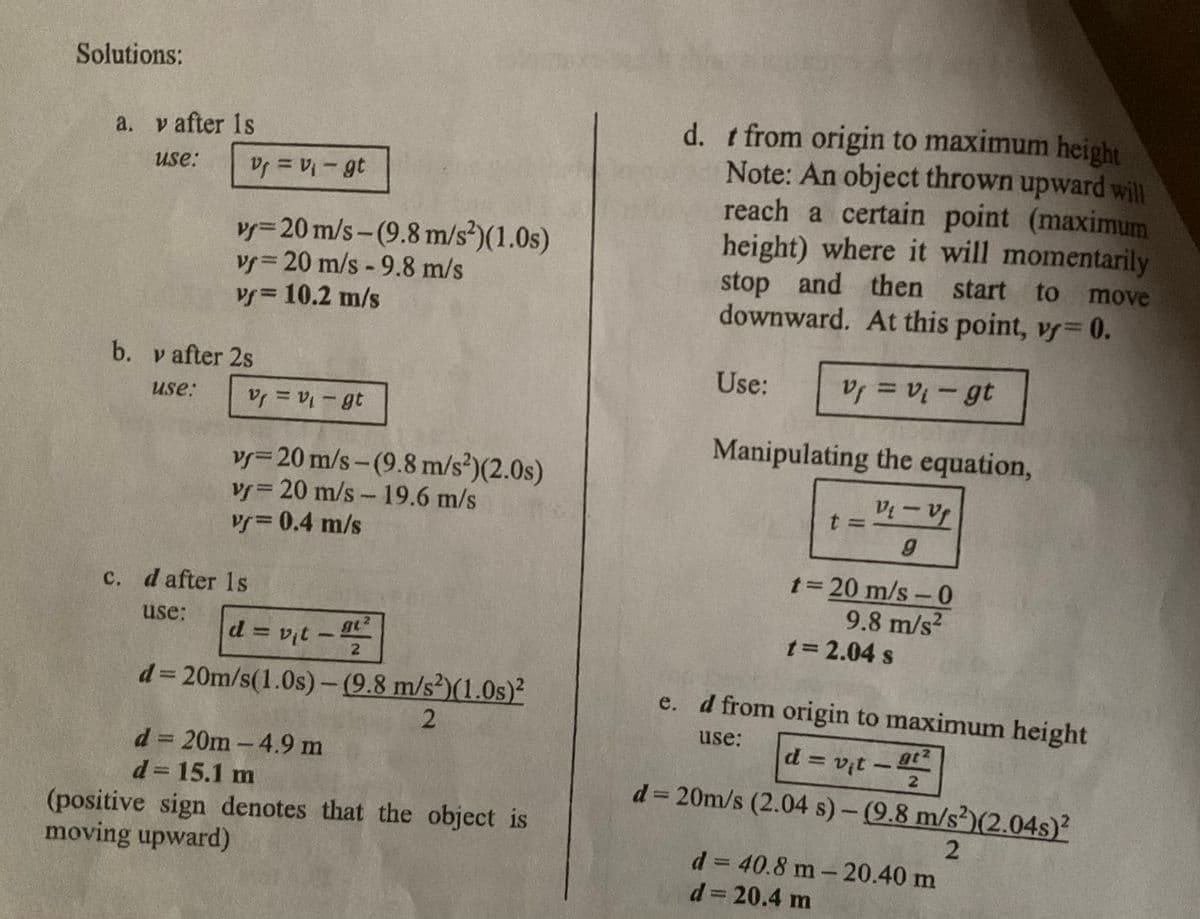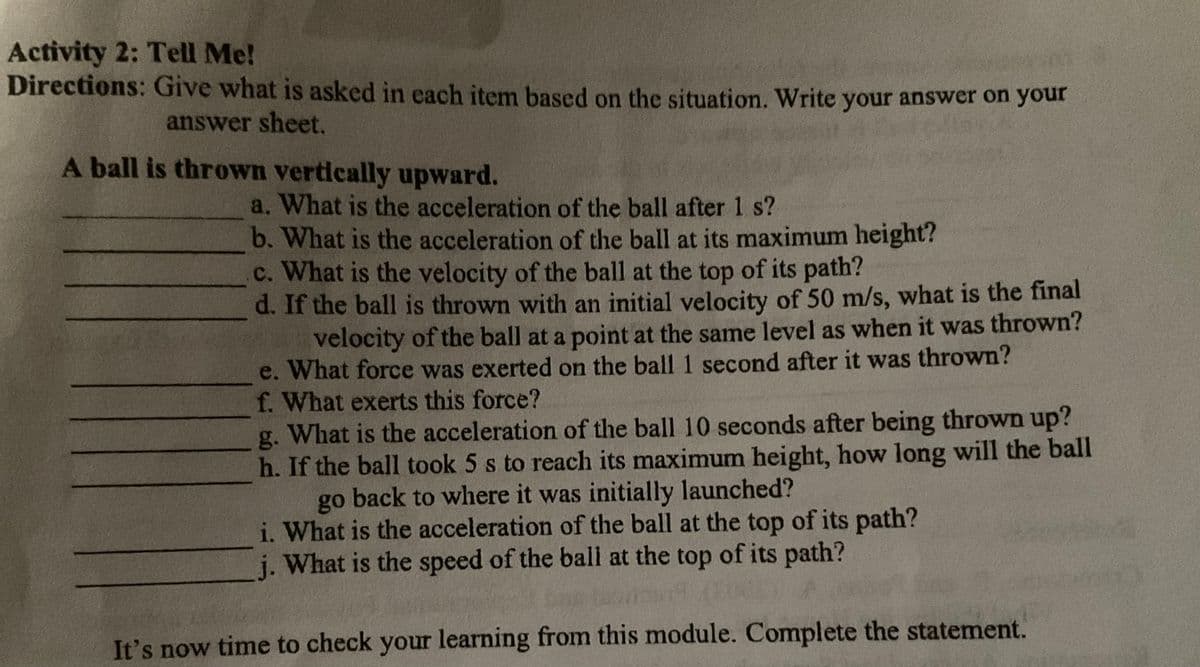Activity 2: Tell Me! Directions: Give what is asked in each item based on the situation. Write your answer on your answer sheet. A ball is thrown vertically upward. a. What is the acceleration of the ball after 1 s? b. What is the acceleration of the ball at its maximum height? c. What is the velocity of the ball at the top of its path?
Activity 2: Tell Me! Directions: Give what is asked in each item based on the situation. Write your answer on your answer sheet. A ball is thrown vertically upward. a. What is the acceleration of the ball after 1 s? b. What is the acceleration of the ball at its maximum height? c. What is the velocity of the ball at the top of its path?
Principles of Physics: A Calculus-Based Text
5th Edition
ISBN:9781133104261
Author:Raymond A. Serway, John W. Jewett
Publisher:Raymond A. Serway, John W. Jewett
Chapter7: Conservation Of Energy
Section: Chapter Questions
Problem 58P
Related questions
Question

Transcribed Image Text:Solutions:
a.
v after is
use:
V₁ = V₁ - gt
vy=20 m/s-(9.8 m/s²)(1.0s)
vf= 20 m/s -9.8 m/s
vf = 10.2 m/s
b. v after 2s
use:
c. d after 1s
use:
v₁ = v₁ - gt
vy=20 m/s-(9.8 m/s²)(2.0s)
vf= 20 m/s - 19.6 m/s
vf = 0.4 m/s
d = v₁t -
912
2
d=20m/s(1.0s) - (9.8 m/s²)(1.0s)²
2
d=20m-4.9 m
d=15.1 m
(positive sign denotes that the object is
moving upward)
d. t from origin to maximum height
Note: An object thrown upward will
reach a certain point (maximum
height) where it will momentarily
stop and then start to move
downward. At this point, vy= 0.
V₁ = V₁ - gt
Use:
Manipulating the equation,
V₁ - Vf
9
t =
t=20 m/s-0
9.8 m/s²
t = 2.04 s
e. d from origin to maximum height
use:
d = v₁t
d=20m/s (2.04 s) - (9.8 m/s²)(2.04s)²
-
gt²
2
2
d = 40.8 m -20.40 m
d = 20.4 m

Transcribed Image Text:Activity 2: Tell Me!
Directions: Give what is asked in each item based on the situation. Write your answer on your
answer sheet.
A ball is thrown vertically upward.
a. What is the acceleration of the ball after 1 s?
b. What is the acceleration of the ball at its maximum height?
c. What is the velocity of the ball at the top of its path?
d. If the ball is thrown with an initial velocity of 50 m/s, what is the final
velocity of the ball at a point at the same level as when it was thrown?
e. What force was exerted on the ball 1 second after it was thrown?
f. What exerts this force?
g.
What is the acceleration of the ball 10 seconds after being thrown up?
h. If the ball took 5 s to reach its maximum height, how long will the ball
go back to where it was initially launched?
i. What is the acceleration of the ball at the top of its path?
j. What is the speed of the ball at the top of its path?
It's now time to check your learning from this module. Complete the statement.
Expert Solution
This question has been solved!
Explore an expertly crafted, step-by-step solution for a thorough understanding of key concepts.
Step by step
Solved in 2 steps

Knowledge Booster
Learn more about
Need a deep-dive on the concept behind this application? Look no further. Learn more about this topic, physics and related others by exploring similar questions and additional content below.Recommended textbooks for you

Principles of Physics: A Calculus-Based Text
Physics
ISBN:
9781133104261
Author:
Raymond A. Serway, John W. Jewett
Publisher:
Cengage Learning

College Physics
Physics
ISBN:
9781305952300
Author:
Raymond A. Serway, Chris Vuille
Publisher:
Cengage Learning

Physics for Scientists and Engineers: Foundations…
Physics
ISBN:
9781133939146
Author:
Katz, Debora M.
Publisher:
Cengage Learning

Principles of Physics: A Calculus-Based Text
Physics
ISBN:
9781133104261
Author:
Raymond A. Serway, John W. Jewett
Publisher:
Cengage Learning

College Physics
Physics
ISBN:
9781305952300
Author:
Raymond A. Serway, Chris Vuille
Publisher:
Cengage Learning

Physics for Scientists and Engineers: Foundations…
Physics
ISBN:
9781133939146
Author:
Katz, Debora M.
Publisher:
Cengage Learning

Physics for Scientists and Engineers, Technology …
Physics
ISBN:
9781305116399
Author:
Raymond A. Serway, John W. Jewett
Publisher:
Cengage Learning

College Physics
Physics
ISBN:
9781938168000
Author:
Paul Peter Urone, Roger Hinrichs
Publisher:
OpenStax College

College Physics
Physics
ISBN:
9781285737027
Author:
Raymond A. Serway, Chris Vuille
Publisher:
Cengage Learning